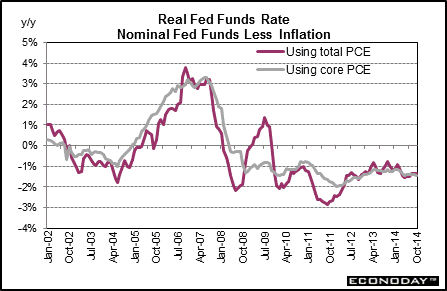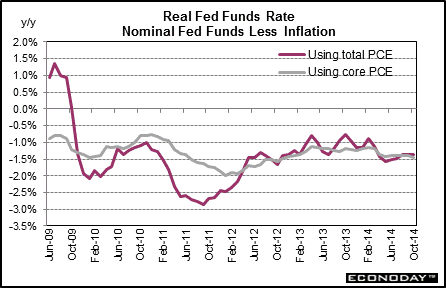
|
Long Term Perspective While the Fed uses changes in the fed funds rate to implement monetary policy, it is the "real" fed funds rate that borrowers and lenders really give attention. The true cost of borrowing is on an inflation adjusted basis. That is, inflation erodes the true cost of paying back the cost of funds borrowed. When making the decision to borrow fed funds, the real rate is nominal fed funds minus the expected rate of inflation. However, the expected rate of inflation is difficult to measure and it is common to estimate the real funds rate using actual inflation rates instead of expected inflation rates. To discount some monthly volatility, it makes sense to use a measure along the lines of a year-ago growth rate. The chart below shows the real fed funds rate based on using headline (overall) PCE inflation and core PCE inflation (excluding food and energy).
During the second half of the 1990s, the real fed funds rate was high due to a high nominal fed funds rate as inflation was moderate. In the early part of the current decade, the real fed funds rate was kept low and even negative to fight sluggish economic growth after the 2001 recession and the fear of deflation (falling prices). Since 2004, the real fed funds rate has swung sharply.
Short Term Perspective At the June 24-25, 2008 FOMC meeting the real fed funds rate became a key debating point over whether the Fed was too loose and accommodating inflation. This issue has resurfaced from time to time since. By either measure using headline inflation or core inflation, the real fed funds rate is very low – even negative by as much as minus 2.8 percent annualized in September 2011. FOMC members arguing that the Fed is not too loose took the position that credit markets are still fragile from the ongoing subprime crisis and that even though rates are low, financial institutions are reluctant to lend. Hence, the real fed funds rate is argued by these FOMC members to not be too low. But that may be a while due to the current sluggishness in the economy, including still elevated unemployment.
Oil prices were up again in 2010 and 2011 and bumped the real fed funds rate back down. But lower energy costs lowered inflation rates in spring 2012, leading the real fed funds rate back up but still in the negative range. A slowing in PCE inflation in 2013 and 2014 led the real fed funds rate to be less negative but somewhat higher inflation pushed the real fed funds rate down somewhat in mid-2014.
|
|||||||
| Legal Notices | ©Copyright 1998-2025 Econoday, Inc. |
powered by
![[Econoday]](images/logo.gif)
![[Apple App Store]](/images/AppleAppStore.png) ![[Econoday on Kindle]](/images/kindle.jpg) 
|
||||||

